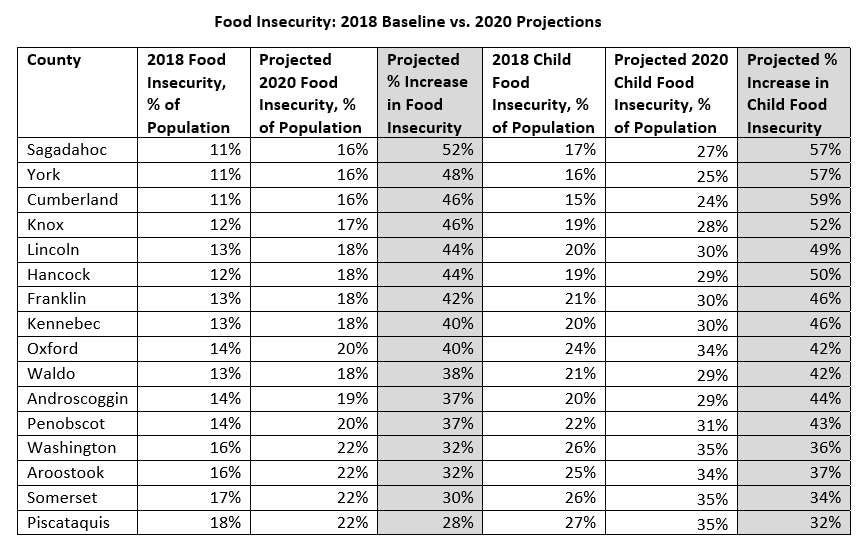
Hunger in Maine expected to soar 40%; nonprofits, businesses respond
 Courtesy / Good Shepherd Food Bank
Good Shepherd Food Bank of Auburn projects hunger to grow by as much as 40% in 2020 due to the pandemic.
Courtesy / Good Shepherd Food Bank
Good Shepherd Food Bank of Auburn projects hunger to grow by as much as 40% in 2020 due to the pandemic.
Hunger across Maine is climbing due to the economic effects of COVID-19. Auburn-based Good Shepherd Food Bank and the Portland nonprofit Full Plates Full Potential are among the organizations assessing and addressing the needs.
40% increase
Maine’s largest hunger-relief organization, Good Shepherd is assessing the local impact in each of Maine’s 16 counties, as statewide rates of hunger are projected to grow by as much as 40% in 2020, according to a news release.
Sagadahoc, York, Cumberland and Knox counties are projected to see the greatest increase in the number of people struggling with hunger.
Piscataquis, Somerset, Aroostook and Washington counties will see less of an increase, but will still rank as being the hungriest counties in Maine. In fact, those counties have the highest rates of hunger in the Northeast. Piscataquis County will see the lowest overall growth in food insecurity, but will still see a substantial increase of 28%.
“These latest county-level projections confirm what we’re seeing on the ground,” said Kristen Miale, president of Good Shepherd Food Bank and a 2020 Mainebiz Business Leader of the Year.
“Our partner food pantries and meal sites in the southern counties have seen the need skyrocket as these more populous areas experienced increased job losses. Our partners in the northernmost counties are seeing big increases, too, but not at the same rate; unfortunately, these counties are accustomed to having high rates of hunger in their communities.”
The new county-level projections are released in conjunction with Feeding America’s Map the Meal Gap study, which uses the most recent data from the U.S. Department of Agriculture and the Census Bureau to analyze local levels of food insecurity. Feeding America used the Map the Meal Gap model to predict changes to food insecurity rates for the overall population and children in response to projected changes to poverty and unemployment in the wake of the coronavirus pandemic.

Pre-pandemic, Maine had approximately 180,000 people (13.6%) struggling with food insecurity. Good Shepherd said it believes this number could climb to as high as 250,000 people, should rates of unemployment and poverty sustain at high rates.
Children at risk
“Unfortunately Maine’s children will see the highest increases in levels of food insecurity,” said Miale. “Similar to overall population trends, the greatest increases are in the southern part of the state, but the impact statewide is devastating.”
Cumberland County’s rate of childhood food insecurity is projected to increase by 59%, with Sagadahoc and York Counties not far behind, bringing the overall rates of child hunger in those counties to around one in four children. The rates of child hunger in counties like Piscataquis, Somerset, Aroostook, Washington, and Oxford could cause one in three kids to experience hunger.
In April, Good Shepherd projected it will incur $6.3 million in additional expenses related to the first six months of its COVID-19 response; the organization has raised over $5 million to specifically fund those needs.
Three-fold food purchases
With this support, the food bank increased its food distribution by 2 million pounds this spring compared to the same time period last year. The food bank purchased the majority of this additional food at a time when food donations from retailers decreased due to supply issues.
In May alone, the food bank purchased 370% more food than it does in an average month.
“COVID-19 has brought a swift and crushing blow to the progress we had made over the past 10 years to improve access to food for Mainers struggling with hunger,” said Miale.
“We have been buoyed over the past three months by the overwhelming support from our partners and the thousands of Mainers who have contributed to our response efforts, but clearly we have our work cut out for us— our state’s recovery from this crisis may bring the greatest demand that our charitable food network has ever seen.”
After school meals
Full Plates Full Potential, a nonprofit working to end child hunger statewide, announced four new recipients of the Oakhurst After School Meal Grant Program.
The four grantees were awarded $19,650 to start or expand their after-school meal programs, according to a separate news release.
The grantees are:
- Bangor Regional YMCA
- Boys and Girls Club of Presque Isle / Aroostook Band of Micmacs
- The Game Loft in Belfast
- Penobscot Nation Youth Program in Indian Island
“These four grantees will serve over 14,000 new after-school meals this coming year,” Anna Korsen, Full Plates Full Potential’s director of advocacy and partnerships, said in the release.
The grant program allows the organization to continue building public awareness of after-school meals and give out more grants for schools to invest in a program.
The state of Maine recently passed legislation supporting more nutritious meals through such meal programs, and Oakhurst Dairy recognized the opportunity to help build the program’s infrastructure over time. The opportunity led to Full Plates and Oakhurst partnering to create the Oakhurst After School grant program.
To date, Oakhurst After School has awarded 13 grants in 2020 to help fund equipment, training and enrichment staffing. Schools can apply for an Oakhurst After School grant here.
“Not only will these grants enable the programs to continue providing meals to children during the summer, but will also allow for infrastructure updates to help sustain Oakhurst After School when school resumes in the fall and beyond,” John Bennett, president and CEO of Oakhurst Dairy, said in the release.










0 Comments